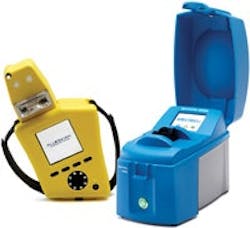About the author: Lawrence Green is western regional manager for Spectro Scientific. Green can be reached at [email protected].
In wastewater treatment facilities, keeping lubricants clean and fit for use can present challenges. Plant operators faced with shrinking manpower and operating budgets may over-lubricate rather than spending maintenance dollars repairing failed equipment. Lubricants can be costly, and the disposal of waste lubricants adds to environmental costs at facilities. Testing the lubricants to determine the oil chemistry can be time-consuming and expose workers to carcinogenic solvents.
Exploring Oil Chemistry
Oil chemistry is a key piece of the lubrication puzzle because it enables analysts to determine if the oil is fit for use, whether there are contaminants in the oil from either excessive wear or external sources, and if the viscosity is sufficient to keep the parts from “bumping into one another.” If any one of these critical parameters is out of specification, the lubricated part can fail prematurely; however, proper maintenance of the chemical quality of the lubricant can extend its useful life.
Older testing methods for oil chemistry involve wet chemistry (acid titration) and oil bath kinematic viscosity testing to measure oxidation potential, total acid number (TAN) and dissolved water. These techniques introduce hazardous waste as a byproduct of the testing, and the test equipment itself is not always robust enough to withstand the rigors of the typical wastewater treatment plant chemist.
This was the situation faced by one of the world’s largest wastewater treatment plants, which treats more than 1 billion gal of wastewater daily and estimates that it takes approximately 100 oil samples from various pumps and gearboxes every month. In the past, the plant used both an oil bath kinematic viscometer and an acid titration instrument to measure viscosity, TAN and oxidation potential of the lubricants. It took two chemists almost an entire morning each day to do the testing, the lab manager reported.
Because the use of hydrochloric acid for the titration and carcinogens like toluene was creating its own waste stream and posing a hazard to the laboratory employees, the lab looked for alternatives to its existing technology to reduce the hazardous waste.
Spectro Scientific supplied a portable battery-powered, handheld infrared spectrometer and a battery-powered kinematic viscometer. The FluidScan Q1000 is an ASTM-certified (D7889) grating infrared spectrometer that uses one drop of lubricant and calculates acid number, TAN and dissolved water in parts per million in about one minute, using no solvents. The Q3050 is a battery-powered handheld portable kinematic viscometer that uses three drops of lubricant (60 μL) and calculates kinematic viscosity at 40°C in less than three minutes. This instrument uses no solvents and has no liquid constant temperature bath.
These two instruments enabled the lab to eliminate the use of the toluene and acids while reducing the amount of time necessary to perform the tests to 90 minutes per day. With better TAN reproducibility and dissolved water testing, the number of retests was reduced as well. The waste stream, once a concern due to the costs involved in buying, transporting and storing the solvents, was eliminated.
Increased Plant Efficiency
The result was that the workload at the plant was reduced to the point where one lab chemist was no longer needed on a day-to-day basis and could be reassigned to other functions. The cost savings from reducing the manpower more than paid for the investment cost of the equipment in less than six months. Of course, this local testing is not meant to replace full-spectrum testing done by a commercial lab (such as wear metal analysis, particle size and morphology); but, on a daily basis, field testing enabled the operators to get results in a matter of minutes versus days. This rapid response is useful when troubleshooting a problem and complements vibration analysis because excessive vibration often is the result of improper lubricant maintenance or operation.
Download: Here
